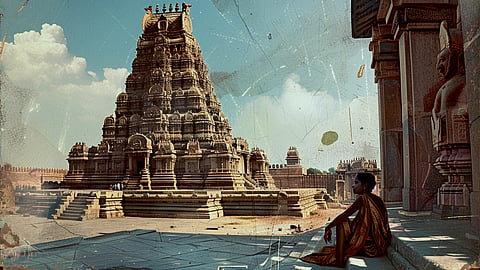- Commentary
- History Vignettes
- Notes on Culture
- Dispatches
- Podcasts
- Indian LanguagesIndian Languages
- Support

A yawning sense of foreboding engrossed the mind of Śivapada Śekhara Rajaraja Chola I in the final year of his long, fruitful, valourous and splendid reign. He was sixty-seven years old, and when he looked back at the last thirty busy years, he had every reason to feel proud, happy, and most of all, content. He had singlehandedly lifted the Chola dynasty from the pits it had sunk into and transformed it into a sweeping empire stretching across the entire East Coast of India, from Kanyakumari to Kalinga. His navy was probably the most powerful and the most feared in the whole of Asia. In one stroke, he pocketed the entire northern half of Sri Lanka after overwhelming Anuradhapura. His magnificent capital at Thanjvur was the opulent melting pot into which thousands of traders, businessmen, artisans and artists poured in.
Yet in this last year of his life, contentment eluded Rajaraja Chola. He was worried about the fate of the Brihadeeshwara Temple after his death. In true Sanatana tradition, Rajaraja regarded this as the crowning triumph of his entire life. It was more precious to him, dearer to his heart than all his daring and extensive military conquests. He was after all, Śivapada Śekhara, and he had fulfilled his pious duty to Shiva by building the Brihadeeshwara Temple. His Shiva was anādi-anaṃta, birthless and eternal, but Rajaraja was fully conscious of his own mortality. His temple had to outlast him, it had to retain all the discipline, traditions, celebrations and institutions that he had spawned and had personally overseen.
And so he decided to do something about it.
This essay series narrates what he did. And what happened to what he bequeathed to the Sanatana civilisation, culture, and society.
The Brihadeeshwara Temple is the stately realisation, the spiritual and devotional artistic finale that arose from the imagination of Rajaraja Chola, an imagination whose impetus was Shiva himself. Like every devout Sanatani King, Rajaraja Chola furthered the tradition of fusing Brahma and Kshatra. His Kshatra won him his extensive empire and it was tempered by his Bhakti towards Shiva.
Befittingly, the presiding deity of Brihadeeshwara is Rajarajeshwara. Interestingly, Thanjavur had no ancient shrine of Shiva and didn’t have a place in the list of celebrated Shiva Kshetras in the Tamil country in the Tevaram. It is to the everlasting glory of Rajajraja that he patronised Nambiyandar Nambi and the Tirumurai took its present shape.
Indeed, the brief story of the construction of the Brihadeeshwara Temple is absolutely thrilling. Here is how K.A.N. Sastry describes it:
The Great Temple of Tanjore impresses us most by the grandeur and simplicity of the design, and the perfect style of its execution. The Great Temple is even more remarkable for the simplicity and the elegance of its sculptures and ornamental designs, than for the majesty of its proportions. The tooling of the stone is so exquisitely delicate, that every detail, including the well-chiselled lettering of the inscriptions, stands out clear and sharp as on the day it left the sculptor’s hands.
Rajaraja Chola didn’t merely build a spectacular temple, he created a mini-civilisation and lasting culture almost from the scratch.
Our first experience when we witness a colossal building is a sense of awe. The sheer size stuns and overwhelms us. While the Brihadeeshwara Temple has the same effect, it transcends the overwhelming and invokes beauty and Bhakti within us. The greatest contrast is the Taj Mahal. Doubtless, it is enormous and magnificent but at its core, it remains a graveyard, a criminal squandering of a bigoted despot’s monument of lust.
Rajaraja spared no effort and employed only the best of talent and carefully handpicked materials and other resources. The full credit goes to his architects. They took extreme caution in designing and blueprinting it: the artistic beauty of the mammoth, final temple had to be immune from its spellbinding size. As we notice even to this day, the architects have pulled off this extraordinary triumph. The other difficulty they faced was on the raw, physical plane: there was no good quarry of building stone in the vicinity of Thanjavur. After scouting for a bit, the exquisite granite that we see in the Brihadeeshwara Temple were transported by road from the quarries at Maramali near Tiruchinapalli, thirty miles from Thanjavur.
As the construction reached the final stages, a hamlet named Sharapallam (literally meaning, “scaffold-hollow”) became the centre of attraction. Located four miles from Thanjavur, a massive incline or ramp was erected at this place. Then, a single block of granite weighing eighty tons was placed on it and it was raised up with great care. This was the majestic Vimana or Shikhara of the Brihadeeshwara Temple.
On the 275th day of 1010 CE, or the twenty-fifth year after Rajaraja Chola ascended the throne, he handed over the exquisite finial or Kalasha, duly sanctified, marking the climax of the construction. The Kalasha was a copper-pot weighing 235 pounds and it was overlaid with a gold plate weighing about 35 pounds. The temple was duly crowned.
The Brihadeeshwara Temple was now ready for formal consecration.
Śivapada Śekhara Rajaraja Chola’s sustained penance had materialised as a grandiose epic in stone after seven years. The fact that it still survives and has largely retained its original grandeur opens new vistas into the meaning of penance itself.
What happened next is even more thrilling.
To be continued
The Dharma Dispatch is now available on Telegram! For original and insightful narratives on Indian Culture and History, subscribe to us on Telegram.
